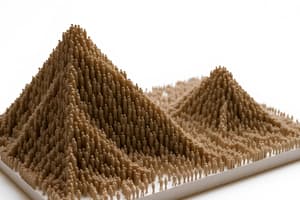Podcast
Questions and Answers
What is the Demographic Transition Model (DTM) based on?
What is the Demographic Transition Model (DTM) based on?
- Birth rate and death rate (correct)
- Death rate and population density
- Economic conditions and education
- Birth rate and migration
What characterizes Stage 1 of the Demographic Transition Model?
What characterizes Stage 1 of the Demographic Transition Model?
Low population growth rate due to high birth and death rates.
What occurs in Stage 2 of the Demographic Transition Model?
What occurs in Stage 2 of the Demographic Transition Model?
Rapid decrease in the death rate while the birth rate remains high.
What describes Stage 3 of the Demographic Transition Model?
What describes Stage 3 of the Demographic Transition Model?
What is true about Stage 4 of the Demographic Transition Model?
What is true about Stage 4 of the Demographic Transition Model?
What characterizes Stage 5 of the Demographic Transition Model?
What characterizes Stage 5 of the Demographic Transition Model?
What is a Population Pyramid?
What is a Population Pyramid?
Flashcards are hidden until you start studying
Study Notes
Demographic Transition Model (DTM)
- The DTM illustrates historical population trends through birth and death rates.
- It outlines how a country's total population growth shifts through distinct stages as it develops economically.
- Each stage reflects a unique relationship between the birth rate (annual births per thousand) and death rate (annual deaths per thousand).
- Countries progress through the model over time due to social and economic influences on birth and death rates.
- Not all stages of the DTM are currently represented by countries; for instance, there are no countries in Stage 1 or Stage 5 presently.
Stage 1
- Characterized by a low population growth rate due to high birth and death rates.
- High death rates often result from poor living conditions and lack of medical knowledge.
- Birth rates are elevated as families have more children to offset high mortality rates.
Stage 2
- Marked by a significant decline in the death rate while the birth rate remains high.
- Population increases rapidly since births outpace deaths.
- Improvements in sanitation, healthcare, and nutrition typically cause the drop in death rates.
Stage 3
- Features low death rates and declining birth rates.
- Economic improvement, increased women’s education, and better access to contraception contribute to decreased birth rates.
- Societal changes, such as urbanization, often impact family size preferences.
Stage 4
- Defined by both low birth and death rates, resulting in stable population growth.
- Societies in this stage often experience higher living standards and better healthcare systems.
- Family planning and individual lifestyle choices further affect birth rates.
Stage 5
- A theoretical stage where the death rate surpasses the birth rate, leading to negative population growth.
- This stage may result from aging populations and societal shifts towards smaller families.
- Immediate effects of this stage may not be evident, suggesting gradual changes over time.
Population Pyramid
- A visual representation showing the age-sex distribution within a population.
- Used to analyze demographic trends and predict future population characteristics.
- Helps identify potential growth patterns, workforce size, and social needs based on age cohorts.
Studying That Suits You
Use AI to generate personalized quizzes and flashcards to suit your learning preferences.




